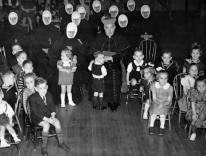So says Catholic jabberer-in-chief Bill Donohue, explaining how he travels to his frequent TV appearances. Who could doubt it? The man can talk. Donohue shared that tidbit in his fiesty reply to NCR editor Joe Feuerherd's takedown. In a follow-up post, Michael Sean Winters did most of the heavy lifting required to rebut Donohue's rebuttal, but I'd like to say a bit more about one of Donohue's favorite topics.
Like a Tourette's patient, Donohue won't stop insisting that the Catholic Church's sexual abuse scandal is really a gay problem. We've been down this road before. As made clear by the scholars conducting the USCCB-commissioned study of the causes of the crisis, homosexuality is not a predictor of sexual abuse. Yet Donohue thinks that because 81 percent of the victims were male the real cause was homosexuality. And if that isn't enough to convince you, Donohue asserts that three-quarters of the victims were postpubescent, noting that the American Pediatric Association says boys start puberty at age ten. In other words, the more postpubescent male victims we find, the more likely it is that we're looking at a gay problem. Obvious, isn't it?
Not quite. First, John Jay researchers did not measure the pubescence of victims. They collected two sets of data about victims. One, the "Cleric Survey," recorded the victims in the following age groups: 1-7, 8-10, 11-14, and 15-17. Researchers presumed that victims aged 11 to 14 were postpubescent; according to the Cleric Survey, 50.9 percent of victims were aged 11 to 14. That's why on page 56 of the "Nature and Scope" study the researchers claim that "the majority of alleged victims were postpubescent." It's not clear to me why John Jay would make that claim, given that researchers didn't collect data on victims' pubescence and that the DSM-IV defines a pedophile as someone with recurrent sexual desires for prepubescent children "generally aged 13 or younger." The American Pediatric Society actually says that for males the onset of puberty--not its conclusion--usually occurs between the ages of 10 and 14. So why would John Jay presume that victims between 11 and 14 years of age were postpubescent? What's more, according to the Cleric Survey, nearly 73 percent of victims were 14 or younger.
John Jay also collected individual surveys for every victim about whom there was data. The "Victim Survey" has a different age breakdown. Table 4.3.2 of the "Nature and Scope" study shows that 60 percent of victims were 13 or under. Granted, the Victim Survey data set isn't as large as that of the Cleric Survey, but it is broken down more carefully. Again, it remains mysterious why a bullet point in the Nature and Scope study summarized only one set of data about victims as: "The majority of alleged victims were postpubescent, with only a small percentage of priests receiving allegations of abusing young children" (4.2 Summary). As far as I can tell, that conclusion doesn't follow from any data collected by John Jay.
Permit me one last repetition. Again and again, Bill Donohue, PhD, and his ilk chant the mantra: 81 percent of victims were male, therefore the crisis is caused by homosexuality--as if the data speak for themselves. They do not. Like the phenomena from which they're drawn, the data are complicated. Just 3.4 percent of the total number of credibly accused priests were responsible for more than one-quarter of all allegations. What conclusions can be drawn from that kind of data? One set of data groups victims across the ages of pubescence, making it difficult to tell which were the targets of true pedophiles and which were not. Another set of data simply lists victims by age. On at least one point, however, both sets of data on victims agree: about 73 percent of victims were 14 or younger.
None of this is to say that homosexuality did not play a role in the crisis. The fact that, according to the Victims Survey, about 25 percent of victims were 15 or older is troubling and deserves investigation. That's what the "Causes and Context" study is doing. You know, the one whose lead researchers have already reported that homosexuality is not a predictor of abuse. Even a limousine conservative should be able to see that.
Please email comments to [email protected] and join the conversation on our Facebook page.
Share
Previous Story
A Pattern of Missteps
Next Story
Seeking Shiny Perfection
